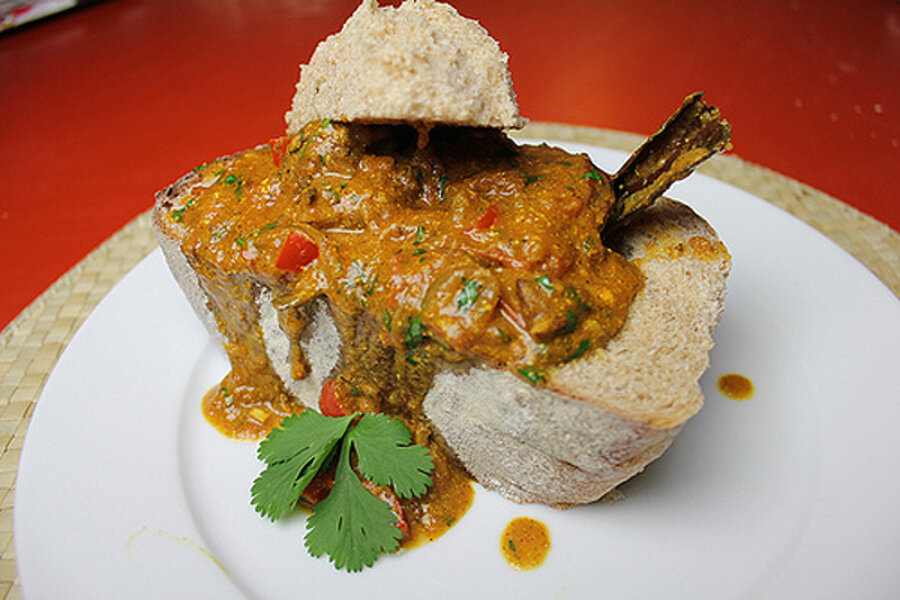South African 'bunny chow'
Loading...
On my train journey home one night a sharply dressed man with a salt-and-pepper mustache had sat down next to me. After about 20 minutes, as we sat in the tunnel under the Hudson River, I became aware that he was craning his neck and taking great interest, as far as I could tell, in my chin. Putting my hand to my chin self-consciously I asked, “Is there something I can help you with?”
“Oh, I’m sorry,” he replied calmly, “didn’t mean to worry you. I was just looking at your scarf. It’s a Manchester United scarf, isn’t it?”
Indeed it was a Manchester United scarf, I told him, at which point a broad smile emerged from under the bushy eaves of his mustache. “I had lunch with Ron Atkinson a few times back in the 1980s, you know.”
“Really?” I replied, instantly curious and detecting some sort of accent that placed him outside of the New York/New Jersey metro area. “Where?”
“In Johannesburg. I was his driver.” Turning to look at him, I saw a pair of very lively brown eyes. Horn-rimmed spectacles sat comfortably amidst abundant but neatly combed salt and pepper hair giving him a slightly professorial look. Guessing his accent as South African, and he of Indian descent, I asked him what he was doing here on the New Jersey transit train to Trenton.
“Heading home.” he said. “Flying out of Newark to go and visit the family. They’re upset that I couldn’t make it for Diwali, but it’s been four years since I was back, so I think they’ll forgive me.”
“I hope you have a great time. I know what it’s like not to see your family for years at a time, too. What brought you to the United States?” I replied.
“Well, I suppose you could say it was business. I came here in 1988 with a suitcase of samples from a South African plastics manufacturing company I was working for and never left.”
“Wow, that is incredibly brave! To come here with nothing and just see what happened.” I blurted stupidly.
“Kinda, but I was 26 at the time and I had the bravery or foolishness of youth in me. It wasn’t easy, and it took a while, but eventually it worked itself out. Funnily enough, by the time I became an American citizen, apartheid had ended and I could have gone home no questions asked, but that country is still a mess today and I have never regretted leaving,” he replied.
Reflecting that I, too, arrived in the US at aged 26 with little more than a suitcase, I asked him how he had come to be driving Ron Atkinson around Johannesburg. Introducing himself as Rahul, we shook hands and he proceeded to fill me in on a piece of Manchester United club trivia.
Ron Atkinson is famous in English football, almost as much for his largely successful career as a manager of a variety of clubs as for his idiosyncratic turn of phrase that, such was their regularity and noteworthiness, became known popularly as “Big Ron-isms” or “Ronglish.” Ironically, for a man famous for his humorous mot-justes, it was a series of unfortunately racist on-air gaffes as a broadcaster that ultimately spelled the end for his career in the game, but years before that in the 1980s he had reached the pinnacle of his managerial career with Manchester United, steering them to two FA Cup victories and one European Cup Winner’s Cup triumph. Underpinning this success throughout Atkinson’s reign had been the athleticism and defense marshaling skills of goalkeeper, Gary Bailey.
English by birth but raised in South Africa, Bailey began playing in Johannesburg before paying his own airfare to Britain for a trial with Manchester United. Ten years later, in the twilight of his career, in the late 1980s, he returned to South Africa to play for Jo’burg professional side, Kaizer Chiefs. It was in this period that, according to Rahul, Ron Atkinson had paid a visit to South Africa to see his old pal and take a short holiday. Late one night, Rahul, who had encountered and befriended Atkinson and Bailey at a night club, ended up ferrying the pair of them home in the wee hours in his uncle’s vintage red Porsche. En route, Big Ron, decided that it was preferable to have a driver on hand for the remainder of his stay, for which Rahul gladly volunteered.
Since my chance encounter with Rahul on the train, South Africa again came to mind when the world lost a shining light in Nelson Mandela, an example to all of us in the art of humility and compassion. Managing to overcome his feelings of injustice and bitterness towards his jailers, oppressors and opponents to unite his homeland and attempt to reconcile its seemingly irreconcilable divides, his story and legacy have always made me hopeful. So, in recognition of his passing, we decided to take a crack at one of South Africa’s signature dishes, bunny chow.
Bunny chow
Serves 2, for more people simply multiply the quantities
Originating in the South African coastal city of Durban, home to a large population of Indian descent, bunny chow is, essentially, nothing more than curry poured into and over quarter of a loaf of white bread. How this curry came to be served with white bread rather than with the more typically Indian accompaniments of rice and roti is not 100 percent clear, but most theories suppose it to have been to allow Indian sugar cane cutters a way of transporting their lunches to their place of work. How the name came about is also unclear, with suggestions variously indicating it was named for the bunia caste who served it or for the bunya or banyan tree under which the curries were sold.
Bunnies, as they are known, are typically ordered in the local slang as “quarter mutton,” referring to the meat therein and the quarter loaf it arrives in, and they are the ultimate scalable dish. Simply specify more of the loaf – a half, a full – to feed more people. That said, a bunny is quite filling, and it is not uncommon for a quarter to be shared between two.
And no, before you ask, there is no rabbit in the recipe, although I daresay some witty soul has made the mental leap and done so, probably with great success. We certainly wouldn’t be opposed to trying it in the future either but wanted to avoid being so trite publicly.
Ingredients
1 lb. stewing lamb cubes, or lamb shoulder chops hacked into chunks
1 large onion, sliced into half moons
3-6 cloves garlic, minced
3-5 medium tomatoes, chopped
3 green cardamom pods
1 stick cinnamon
1-2 whole star anise
3-5 curry leaves
1 teaspoon ground hot pepper
3 tablespoon Madras curry powder
2 teaspoon garam masala
1 teaspoon ground coriander seed
1 teaspoon ground turmeric
Water
Salt
Plain yogurt
Cooking oil or clarified butter
1 large unsliced loaf of your favorite white or wholewheat/meal bread. Tin loaves are preferable as receptacles because they stand up best by themselves.
3 tablespoon chopped cilantro
1. In a deep, heavy pot over medium flame, heat cinnamon stick, cardamom pods and star anise in 2 tablespoons cooking oil, for 2-3 minutes.
2. Add onions and cook until translucent. Remove onions and whole spices to a plate and reserve.
3. Add another tablespoon of oil to the pot and cook the lamb until nicely browned on all sides.
4. Add a fourth tablespoon of oil and add powdered spices and curry leaves, stirring well. Cook for no more than two minutes before adding garlic and chopped tomatoes.
5. Stir mixture well until a kind of paste is formed before returning onions and whole spices to the pot and adding enough water to cover everything.
6. Bring to a simmer and cook covered for at least an hour, preferably two.
7. After curry is cooked, taste for seasoning, and add salt (and in our case, the juice of half a lemon) to taste.
8. Add two or three tablespoons of plain/natural yogurt (or cream, if you’re feeling fancy) and stir well. Taste again.
9. It should be nicely spicy and thick enough to coat the back of a spoon. If it’s still a bit thin, either continue to simmer uncovered until the right thickness is achieved, or sieve a tablespoon of flour into it, and it should thicken up nicely.
10. Cut your loaf into quarters, pull out some of the insides and reserve. Place quarter loaves on plates. Spoon curry into hollow bread, sprinkle with chopped cilantro, and place reserved doughy inside of loaf on top.








